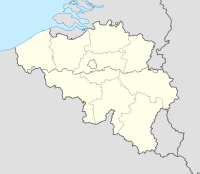
Back معركة هالن Arabic Бітва пад Халенам Byelorussian Бітва пад Халенам BE-X-OLD Emgann Halen Breton Gefecht bei Halen German Halengo gudua Basque Bataille des casques d'argent French Batalla de Haelen Galician קרב האלן HE Battaglia di Haelen Italian
| Battle of Halen | |||||||
|---|---|---|---|---|---|---|---|
| Part of the Battle of the Frontiers in the First World War | |||||||
 Contemporary postcard depicting the failure of the German cavalry at Halen | |||||||
| |||||||
| Belligerents | |||||||
|
|
| ||||||
| Commanders and leaders | |||||||
|
| |||||||
| Strength | |||||||
|
| ||||||
| Casualties and losses | |||||||
|
| ||||||
Halen (Haelen), a market town in the province of Limburg in eastern Belgium | |||||||
The Battle of Halen (German: Gefecht bei Halen), also known as the Battle of the Silver Helmets (Dutch: Slag der Zilveren Helmen; French: Bataille des casques d'argent) because of the many cavalry helmets left behind on the battlefield by the German cuirassiers, took place on 12 August 1914 at the beginning of the First World War, between German forces led by Georg von der Marwitz and Belgian troops led by Léon De Witte. The name of the battle alludes to the Battle of the Golden Spurs in 1302, where 500 pairs of golden spurs were recovered from the battlefield. Halen (Haelen in French) was a small market town and a convenient river crossing of the Gete and was situated on the principal axis of advance of the Imperial German army.[a] The battle was a Belgian tactical victory, but did little to delay the German invasion of Belgium.
Cite error: There are <ref group=lower-alpha> tags or {{efn}} templates on this page, but the references will not show without a {{reflist|group=lower-alpha}} template or {{notelist}} template (see the help page).
